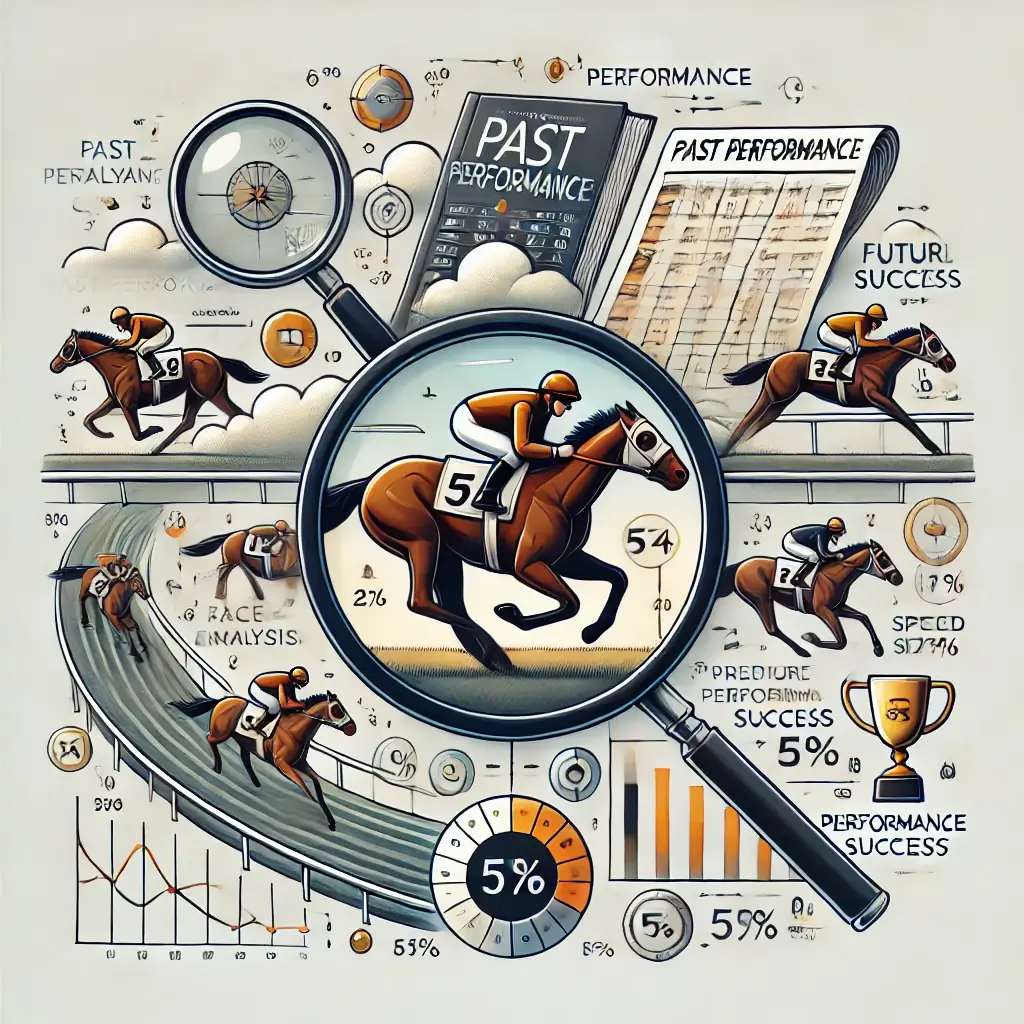How to Analyze Past Performance to Predict Future Success
In horse racing, past performance is one of the most reliable indicators of future success. By analyzing a horse's previous races, you can gain valuable insights into its capabilities, preferences, and potential for upcoming events. Whether you’re a novice bettor or a seasoned pro, understanding how to dissect past performance data is crucial for making informed betting decisions. This guide will walk you through the key factors to consider and provide expert strategies for predicting future success based on past performances.

Understanding Past Performance Data
Past performance data is a comprehensive record of a horse’s previous races, typically found in racing forms or databases. This data includes a variety of metrics that reflect how a horse has performed under different conditions. Here are the most important components to focus on:
Key Components of Past Performance
- Race Record: This includes the number of races the horse has run, and how often it has finished in the top three positions (wins, places, and shows). It’s a quick snapshot of the horse’s overall success.
- Recent Form: A horse's most recent races are often the best indicators of its current condition and potential performance. Look for trends such as consistent finishes or improving placings.
- Class: The level of competition the horse has faced in previous races is crucial. A horse that has consistently performed well in high-class races may have an edge over competitors from lower-class races.
- Distance: Horses have preferred race distances, and their performance can vary significantly depending on the length of the race. Look for patterns in how a horse performs at different distances.
- Track Conditions: Evaluate how a horse has performed under various track conditions (firm, soft, heavy, etc.). Some horses excel in specific conditions, while others may struggle.
- Jockey and Trainer Stats: The combination of a skilled jockey and a top trainer can significantly impact a horse's performance. Review the success rates of jockey-trainer partnerships to gauge their effectiveness.
- Running Style: Whether a horse prefers to lead, stalk, or come from behind can influence its success in certain race setups. Understanding the horse’s running style helps in predicting how it might fare against the competition.
Analyzing Past Performance: Step-by-Step
Now that you know what data to look for, let’s break down the process of analyzing past performance to predict future success.
1. Start with the Race Record
Begin by reviewing the horse’s overall race record, focusing on win percentages and top-three finishes. A horse with a high win percentage in its class is likely to continue performing well. However, also consider how long it has been since its last win; a horse on a losing streak might be past its prime.
- Winning Consistency: Look for horses that consistently finish in the top positions. Consistency is often a good indicator of reliability, even if the horse doesn’t win every time.
- Recent Performance: Pay extra attention to the last few races, as they often reflect the horse’s current form. Horses in good form are more likely to perform well in upcoming races.
2. Evaluate the Class and Competition
Consider the level of competition the horse has faced. Success in lower-class races doesn’t always translate to success in higher-class events. Horses stepping up in class need to be evaluated carefully.
- Class Rises and Drops: Horses moving up in class may face tougher competition, while those dropping in class may have an advantage. Analyze how the horse has handled previous class changes.
- Head-to-Head Matchups: Check if the horse has raced against today’s competitors before, and how it fared in those matchups. A strong record against similar horses can be a positive sign.
3. Assess Distance Performance
Analyze how the horse has performed at the race distance. Some horses are sprinters, excelling at shorter distances, while others are stayers, better suited to longer races.
- Preferred Distance: Identify the distance range where the horse has been most successful. Horses running at their preferred distance are more likely to perform well.
- Stamina and Speed: Evaluate whether the horse has the stamina for longer races or the speed for sprints. This can help you predict how it will handle the upcoming race.
4. Consider Track Conditions and Surface Preferences
Horses often have strong preferences for certain track conditions and surfaces. Past performance on similar tracks can be a good predictor of future success.
- Surface Analysis: Check how the horse has performed on different surfaces (turf, dirt, synthetic). Some horses excel on specific surfaces, which can give them an edge.
- Weather Impact: Take note of how the horse performs in wet or dry conditions. Horses that thrive in specific weather conditions are worth backing when those conditions are present.
5. Review Jockey and Trainer Influence
The jockey and trainer can have a significant impact on a horse’s performance. A top jockey and a skilled trainer often improve a horse’s chances of winning.
- Jockey-Trainer Combinations: Look for successful jockey-trainer partnerships. High win rates for a particular combination can be a strong indicator of future success.
- Recent Success: Consider the recent form of both the jockey and the trainer. If they’ve been performing well, it’s likely they’ll continue to do so.
6. Analyze Running Style and Race Setup
A horse’s running style plays a crucial role in its performance, especially in races where the pace or field size might suit certain styles better than others.
- Pace Scenarios: Identify whether the race is likely to be fast or slow-paced. Horses that prefer to lead might struggle in a race with many front-runners, while closers might excel if the pace is too fast.
- Field Size: Smaller fields can favor front-runners, while larger fields might benefit horses that come from behind. Adjust your expectations based on the field size and running styles of the competitors.
Advanced Strategies for Predicting Success
Once you’ve mastered the basics of analyzing past performance, you can refine your approach with these advanced strategies:
1. Use Speed Figures
Speed figures are a valuable tool for comparing the performance of horses across different races and conditions. These figures take into account the time it took a horse to complete a race, adjusted for factors like track condition and race distance.
- Comparative Analysis: Use speed figures to compare horses in the same race. A horse with consistently high speed figures is likely to perform well, even if its recent form isn’t stellar.
2. Factor in Layoffs and Breaks
Horses returning from a break or a layoff can be tricky to assess. While a fresh horse might perform well, it’s also possible that it needs a race or two to get back to peak form.
- Recent Layoffs: Check how the horse has performed after previous layoffs. Horses with a strong record of performing well after breaks are more likely to succeed again.
- Fitness Concerns: If a horse has been off the track for an extended period, consider whether it’s likely to need a race to regain full fitness.
3. Consider Weight and Handicaps
In handicap races, the weight a horse carries can significantly impact its performance. Analyze how the horse has fared under different weights in the past.
- Weight Trends: Look for trends in how the horse performs with different weight assignments. Horses that have performed well with higher weights might have an advantage if they’re carrying less weight this time.
Common Mistakes to Avoid
1. Ignoring Recent Form
While overall race record is important, recent form is often the best indicator of a horse’s current ability. Don’t overlook a horse’s last few performances.
2. Overvaluing Class Rises
A horse moving up in class might struggle against tougher competition, even if it has been dominant at lower levels. Evaluate class rises carefully and avoid overestimating the horse’s chances.
3. Disregarding Track Conditions
Track conditions can dramatically affect a horse’s performance. Always factor in how the horse has performed under similar conditions in the past.
Conclusion
Analyzing past performance is a critical skill for any serious horse racing bettor. By understanding the key components of past performance data and applying the strategies outlined in this guide, you can make more informed predictions about a horse’s future success. Whether you're betting on a high-stakes race or just enjoying a day at the track, mastering the art of past performance analysis will give you the edge you need to make smarter bets and increase your chances of winning.
More Betting Guides
Fundamentals of Horse Racing Betting
- Bankroll Management for Horse Racing: Tips to Stay Profitable
- Horse Racing Betting 101: A Beginner’s Guide to Understanding Bets, Racing Forms, and More
- Understanding Odds: How to Maximize Your Winnings
Betting Strategies
- Each-Way Betting: A Safer Approach to Horse Racing Bets
- How to Pick Winners in Horse Racing: Tips from the Pros
- Value Betting in Horse Racing: How to Identify and Capitalize on Undervalued Horses
Advanced Betting Techniques
- Mastering Exacta Betting: From Beginner to Pro
- Mastering Multi-Race Bets: Strategies for Pick 3, Pick 4, Pick 5, and Pick 6 in Horse Racing
- Trifecta and Superfecta Betting: Strategies for Big Payouts
Analysis and Prediction
- How to Analyze Past Performance to Predict Future Success
- Jockey and Trainer Analysis: How to Factor Human Elements into Your Bets
- The Impact of Track Conditions and Biases: How to Adjust Your Bets
Specialized Knowledge
More of our latest tips & picks
💎 Value Tips Finder
Discover horses with high tipster consensus but generous odds

Great Britain

United States
Thursday
Thursday
Thursday
Thursday
Thursday

Ireland
🏇 Upcoming Races
See the most-tipped horses for races just around the corner.

Thorough Brett
"Being able to see what other tipsters are picking is fantastic. I love how you can quickly spot trending horses and get a feel for where the smart money is going. The popular picks feature is super useful."


